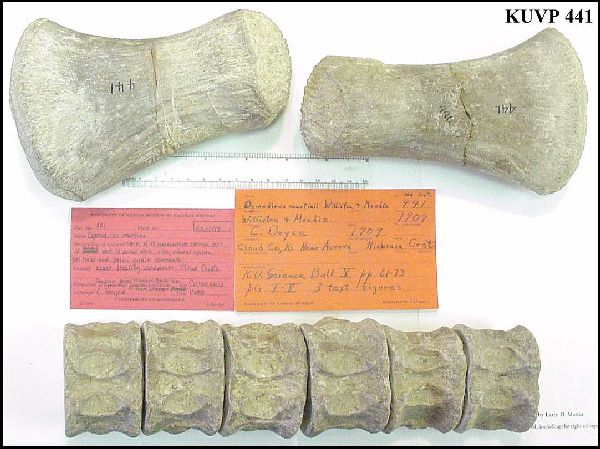
Williston, S. W. and R. L. Moodie. 1913.
New plesiosaurian genus from the Cretaceous of Nebraska.
[Ogmodirus martini]
Bulletin of the Geological Society of America 24: 120-121.
Wherein Williston and Moodie, in the abstract of a paper presented at the 1912 meeting of the Paleontological Society in New Haven, Connecticut, name a new genus and species of plesiosaur from Cloud County, Kansas. Note the original spelling of Ogmodirus martini. When Moodie (1916) referred to the specimen, he added an extra "i" added to "martinii." A year later, Williston and Moodie (1917) published the paper describing this species and also included the mis-spelling. Although the mis-spelling has been used in the literature since then, the original genus name (martini)is the correct spelling (see also Schultze, et. al., 1985, p 50; Storrs, 1999). Note that when it was described in more detail (Williston and Moodie, 1917) mention was made of bite marks from sharks one one of the propodials. The bite marks have seen been identified as those of Squalicorax from the serrations that are preserved.
| 120 PROCEEDINGS OF THE
PALEONTOLOGICAL SOCIETY
NEW PLESIOSAURIAN GENUS FROM THE NIOBRARA CRETACEOUS OF NEBRASKA. BY S. W. WILLISTON AND ROY L. MOODIE (Abstract) The new genus is a member of the widely distributed family, the Elasmosauridae, and is based on a complete series of cervical vertebrę with limbs and girdle elements. The distinguishing characters of the new genus are the short, uniform centra of the cervical vertebrę from Cloud County, Kansas. The characters of the limbs show the animal to have been a young but nearly mature individual. There are no evidences for the formation of the articular surfaces of the ends of the propodials for articulation with the mesopodial elements. The cervical centra have on the ventral surface throughout a pair of vascular foramina, and the surfaces of all the skeletal elements show evidence of the presence of a richly vascular periosteum. There are 51 cervical vertebrę preserved with a total length of nearly two meters. The individual vertebrę increase in length and breadth according to the following measurements: 3d cervical vertebrę 20 mm. long 30 mm. wide |
REGISTER OF THE NEW HAVEN MEETING
121 The
new generic and specific terms Ogmodirus martini are proposed for the new animal.
|
Suggested reading:
Moodie, R. L. 1916. The structure and growth of the plesiosaurian propodial. Journal of Morphology 27: 401-410.
Schultze, H.-P., L. Hunt, J. Chorn and A. M. Neuner. 1985. Type and figured specimens of fossil vertebrates in the collection of the University of Kansas Museum of Natural History, Part II. Fossil Amphibians and Reptiles. Miscellaneous Publications of the University of Kansas Museum of Natural History 77: 66 pp.
Storrs, G. W. 1999. An examination of Plesiosauria (Diapsida: Sauropterygia) from the Niobrara Chalk (upper Cretaceous) of central North America, The University of Kansas Paleontological Contributions, (N. S.), No. 11, 15 pp.
Williston, S. W. and R. L. Moodie. 1913. New plesiosaurian genus from the
Cretaceous of Nebraska. Bulletin of the Geological Society of America 24: 120-121.
(Abstract reporting Ogmodirus martini - note original spelling)
Williston, S. W. and R. L. Moodie. 1917. Ogmodirus martinii, a new plesiosaur
from the Cretaceous of Kansas. Kansas University Science Bulletin 10: 61-73, figs. 1-3.,
plates 1-5. (see also Moodie, 1916)